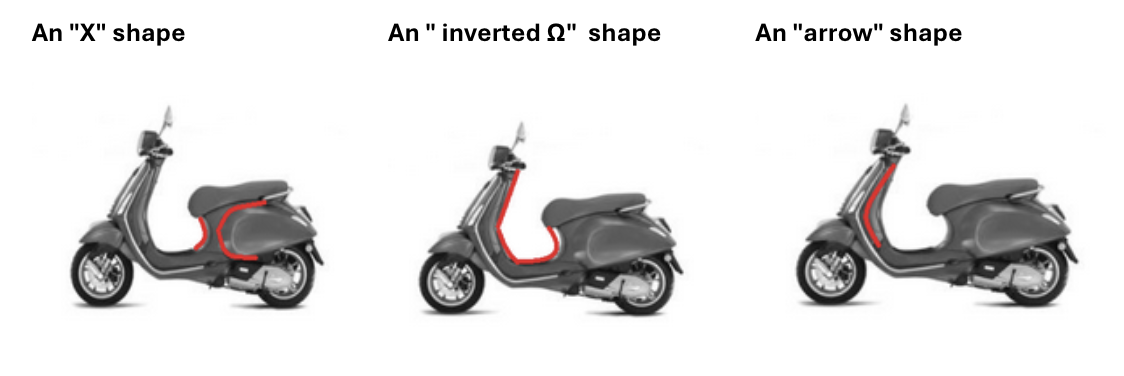Piaggio’s 3D trademark registration hits a dead end

The EUIPO has refused the attempt by the Piaggio Group, manufacturer of the iconic Vespa, to register a three-dimensional trademark representing the shape of a scooter. The failure of the 3D trademark registration illustrates once again the difficulty of protecting non-traditional trademarks, as Alexis Thiebaut explains.
The Italian company Piaggio & C.SpA (the Piaggio Group) filed a three-dimensional EU trademark (EUTM) application (pictured below) in June 2024 to protect the shape of a scooter, in classes 12 (scooters) and 28 (scooter models).

In its decision of 15 April 2025, the EU Intellectual Property Office (EUIPO) completely – and unsurprisingly – refused the registration of the EUTM application on the basis that:
- The relevant public does not necessarily perceive a shape mark consisting of the appearance of a product in the same way as it perceives a word mark;
- Only a trademark that deviates significantly from the norm or practices of the sector is not devoid of distinctive character; and
- The shape of this scooter does not deviate significantly from the standards and practices of the sector concerned.
In fact, it is a scooter with a curved shape and two rear-view mirrors above the handlebars, characteristics that the EUIPO considers typical and usual for such a product.
As part of its argument, PIAGGIO & CSPA highlighted three features of its scooter that it considered to stand out from industry standards, namely:

These arguments were, however, dismissed by the EUIPO, which found that "while it is true that the trademark applied for and the examples provided by the Office may present some differences, the overall impression resulting from them is very similar, which will lead consumers to perceive the contested sign as a simple variation of similar shapes existing on the market."
The Piaggio Group also referenced the earlier registration of its three-dimensional EU trademark No. 011686482, reproduced below. However, the EUIPO notes that this was maintained in the register, following an action for invalidity brought by a third party, due to its distinctive character acquired through use, the Board of Appeal (R0359/2021-5) and EU General Court (T-19/22 ) having confirmed the absence of intrinsic distinctive character of this trademark.

In this respect, the EUIPO points out that these two marks are almost identical and that, therefore, the analysis of the intrinsic distinctive character of this new mark cannot be different from that carried out by the Board of Appeal and EU General Court for this earlier mark.
Key takeaways for brand owners
This decision once again highlights the great difficulty brand owners have in protecting their three-dimensional trademarks and, more broadly, their non-traditional trademarks (colour marks, position marks, pattern marks, etc). It also confirms that the only possible route currently is that of acquiring distinctive character through use.
This latter solution remains complicated to implement in practice, however, as the level of proof required by the European authorities is dissuasive. Indeed, even if it is not necessary to present evidence for each member state, the latter must demonstrate the acquisition of distinctive character in all EU member states.
In its March 2024 judgment (T‑652/22 ) relating to the orange colour of Veuve Clicquot champagne, the EU General Court specified that certain evidence could concern several member states, or even the whole of the EU, and that it "is possible that, for certain goods or services, the economic operators have grouped several member states together in the same distribution network and have treated those member states […] as if they were one and the same national market", thus making it possible to group together several countries of the EU.
Even if this judgment suggests a relaxation of the requirements, it remains necessary to prove that the mark in question has acquired a distinctive character through use throughout the EU.
Given the Piaggio Group remains the owner of the earlier three-dimensional trademark, which is very close to the refused trademark, the consequences of this most recent refusal are arguably limited. On the other hand, brand owners will be hoping for further relaxation by the European authorities when assessing the distinctive character of non-traditional trademarks to allow for a more effective defence of such rights across the EU.
To discover best practices for protecting non-traditional trademarks, such as 3D trademarks, in the EU, watch our webinar, speak to your Novagraaf attorney or contact us below.
Alexis Thiebaut is a Trademark Attorney at Novagraaf in France.